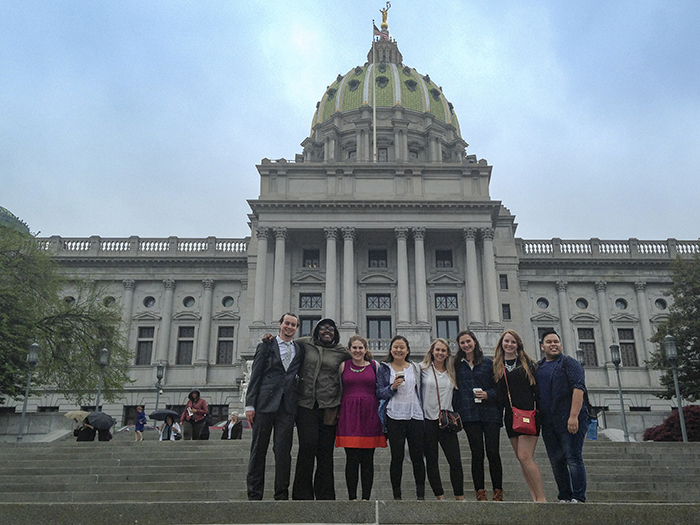Arts, Activism and Civic Engagement

Student projects aim to improve lives, communities through art
by MaryAlice Bitts-Jackson
Entering the magnificent rotunda of the Pennsylvania Capitol, it was hard to miss the irony. It was Arts Advocacy Day, and as they passed under the 272-foot dome on their way to fight on behalf of arts funding, the students and professor were greeted by ornate mosaics, sculptures and murals—including medallions representing four societal pillars: law, science, religion and art.
“I felt like I stepped into a different world,” said Sydney Cross '17 (history).
“It made me want to take the people we were meeting with—people who work there every day—out there and say, ‘Look up!’ ” said Erin Crawley-Woods, visiting assistant professor of dance,
The students were enrolled in Crawley-Woods’ Community Engagement and Artistic Activism course, and they’d been focusing on the ways that the arts can shape and inform civic life. One month earlier, they’d put theory to practice, organizing a flash mob on campus, a protest against the exploitation of women. Then it was time to take what they were learning into the wider community, beginning at the local level.
Building community
Cross, who interned with a New York nonprofit and is interested in a career in arts administration, worked on grant writing and research projects, while Armando Moreno ’20 (theatre arts), a dancer, taught bachata to seniors and students. Sabrina Frost ’20 (biochemistry & molecular biology) teamed up with Emelia Brenneman ’19 (religion, psychology) to co-teach dance to adults with intellectual and developmental disabilities, and also worked with Erin Hogan ’19 (educational studies) on a dance lesson for an after-school program. Alyssa Giordano ’17 (theatre arts, psychology) organized a similar program for a public Earth Day event at the College Farm; Jackson Zyontz ’17 (art & art history) created a community tape-art mural; and Kenya Bullock ’19 (undeclared) laid the groundwork to bring a branch of a New Jersey-based art program to Carlisle. Bullock plans to partner with Carlisle High School on that project next year.
The final assignment: write a mock grant proposal for a statewide arts project. But when the students learned about upcoming National Arts Advocacy Day events, they added a larger-scope project to their plates.
Artful legislation
Held annually in the spring, Arts Advocacy Day brings American cultural, civic and grassroots organizations together to underscore the importance of strong public policies and increased funding for the arts. After a briefing on state budgeting and state advocacy protocol by the managing director of the state’s Citizens for the Arts in Pennsylvania, the students traveled with Crawley-Woods to Harrisburg, a half-hour’s drive from campus, to attend a meeting of the arts and culture caucus.
Arts funding is a charged issue in America at the start of a new presidential administration, and perhaps notably in Pennsylvania, where $9.59 million in arts funding was proposed to be removed as a line item in the general fund. The students paired with experienced arts advocates and attended a caucus meeting and other informal meetings with lawmakers to relate their experiences as artists, arts interns and community volunteers and share their views of the ways the arts can enhance communities and lives.
The experience shed light on the complexities of state budgeting and on the process of state-level decision-making. Perhaps most critically, says Crawley-Woods, students identified what activist approaches are likely to work within such a setting, and why. “It ties together an overarching theme of our course—there are many ways to go about activism, advocacy, and art making,” she says. “Sometimes you engage with a system and work within it; sometimes you disrupt and push against it. It’s about choosing which will be the most effective tool for the task at hand.”
“You just have to do your part and share your passion,” says Cross. “Art-making gives each of us ownership, an opportunity at community-building and a means to social action. Every child deserves the chance to create.”
Learn more
Published May 11, 2017